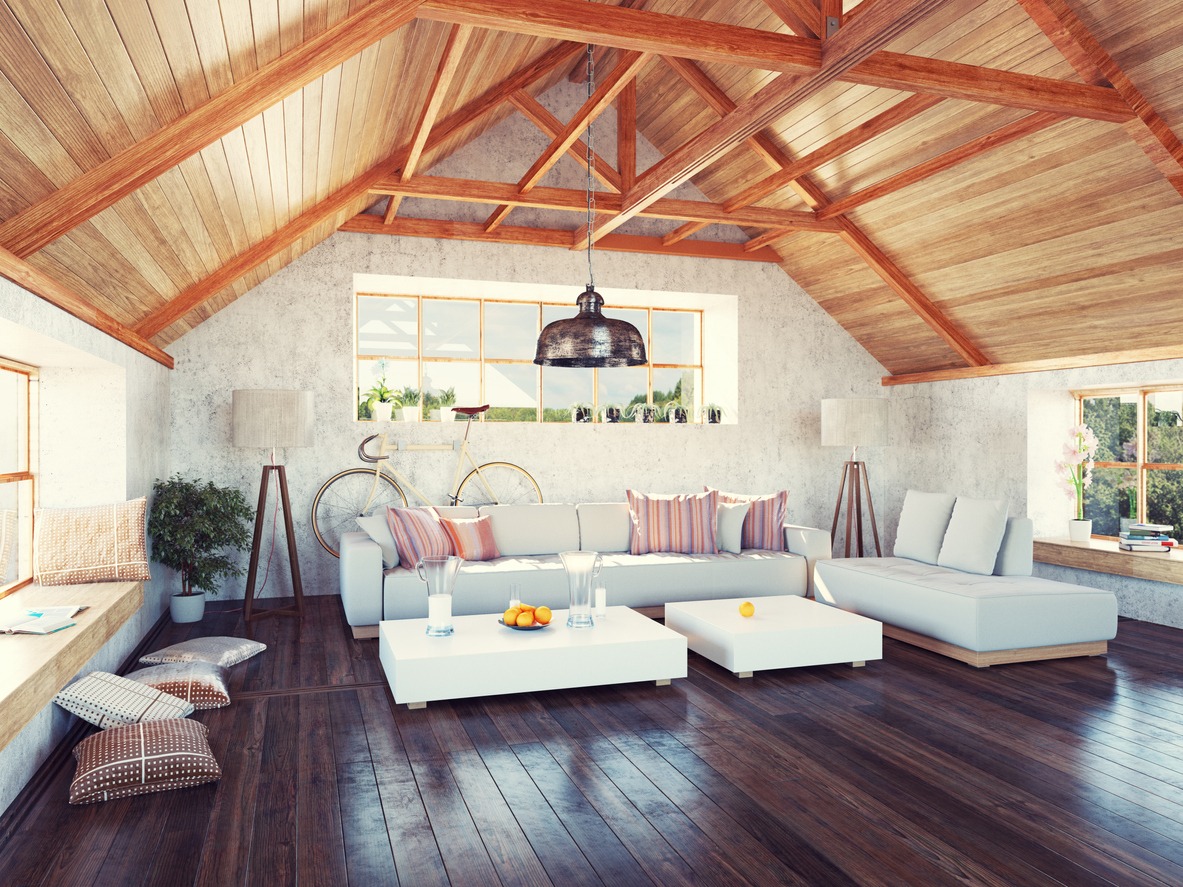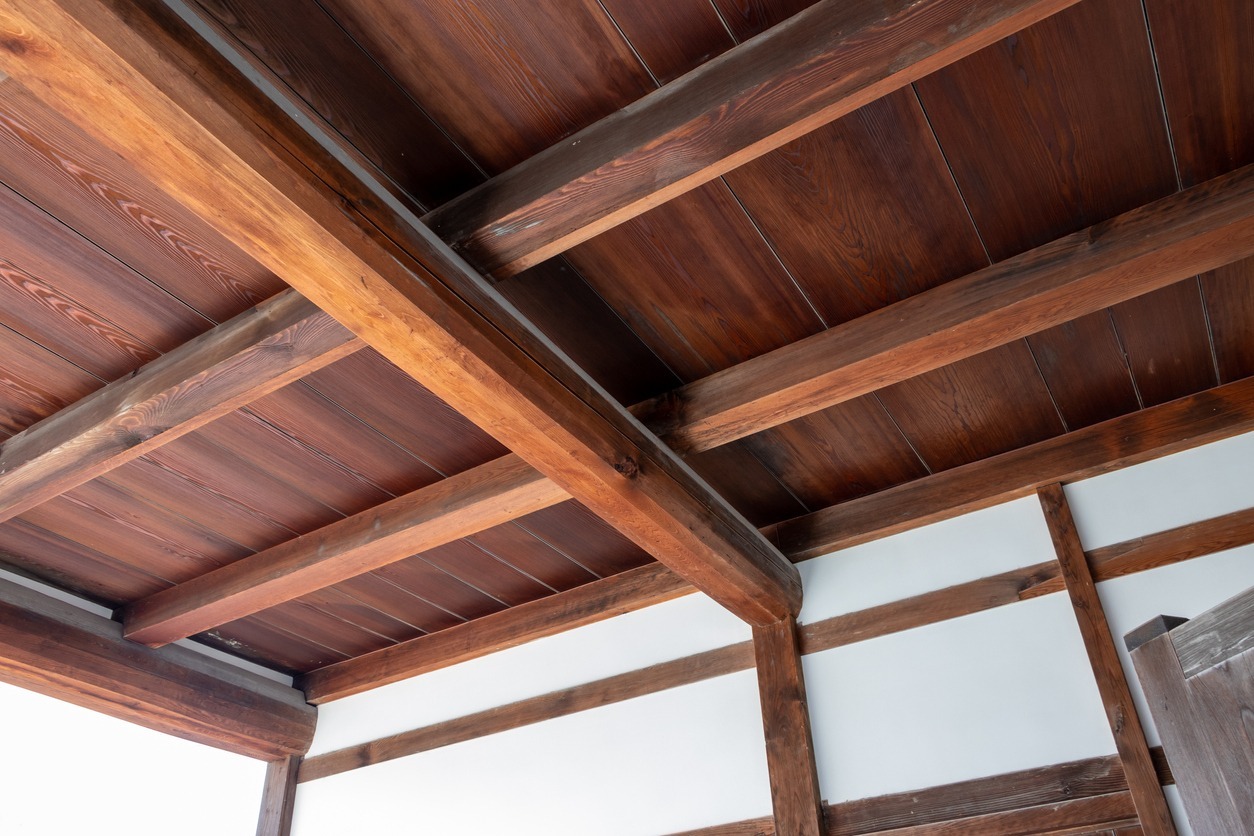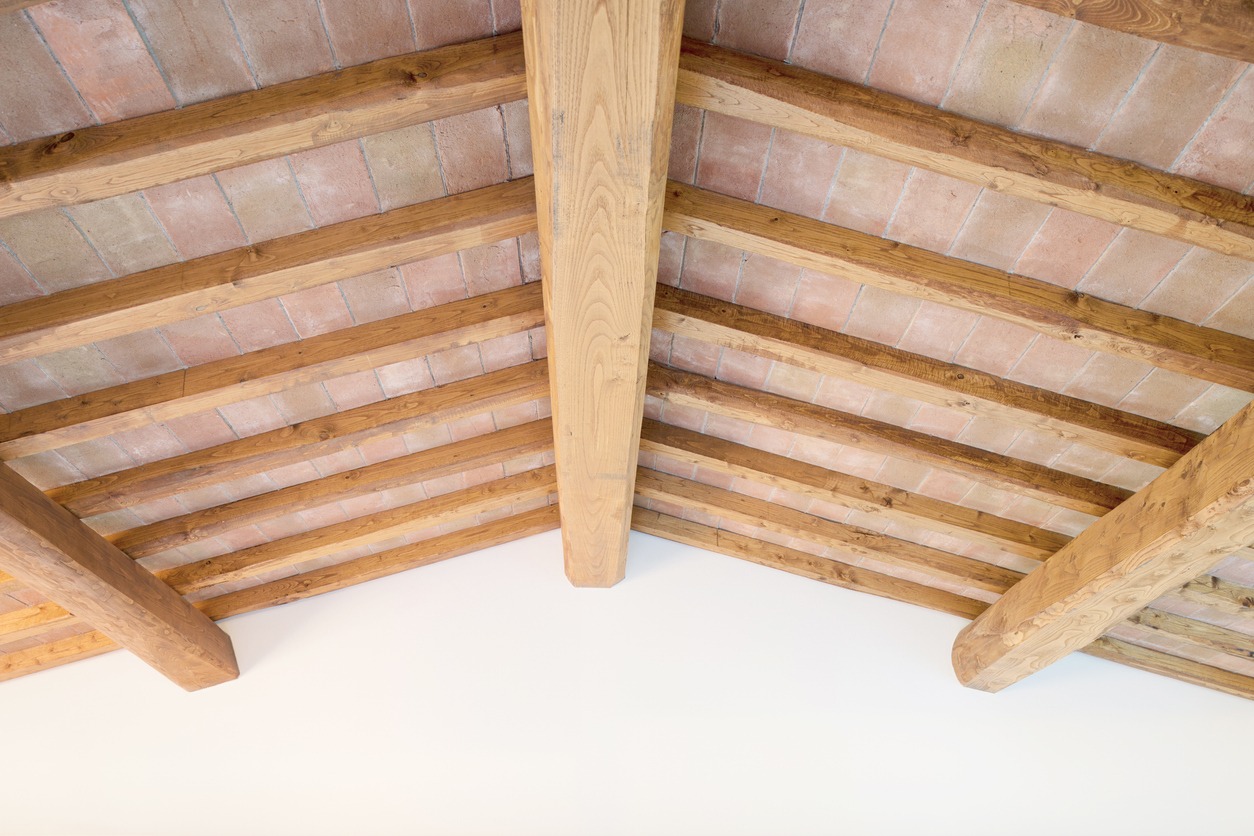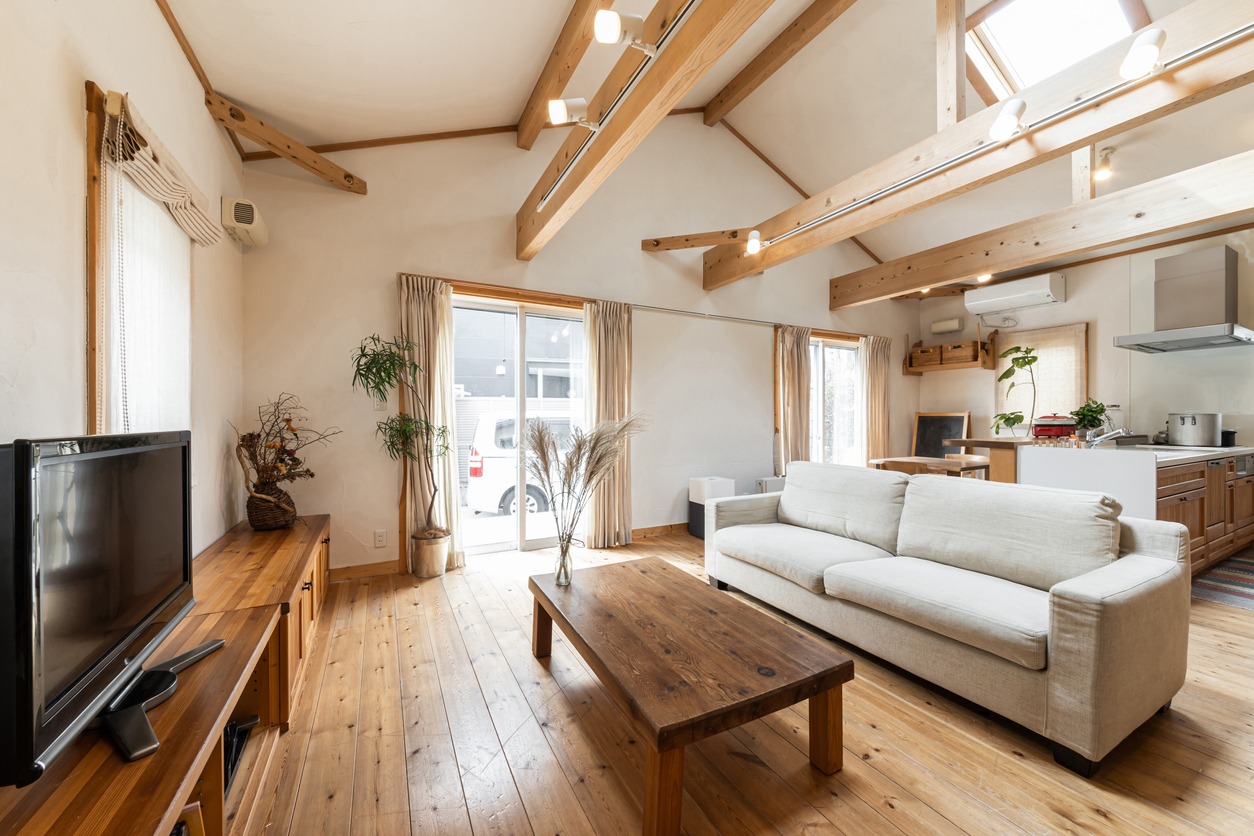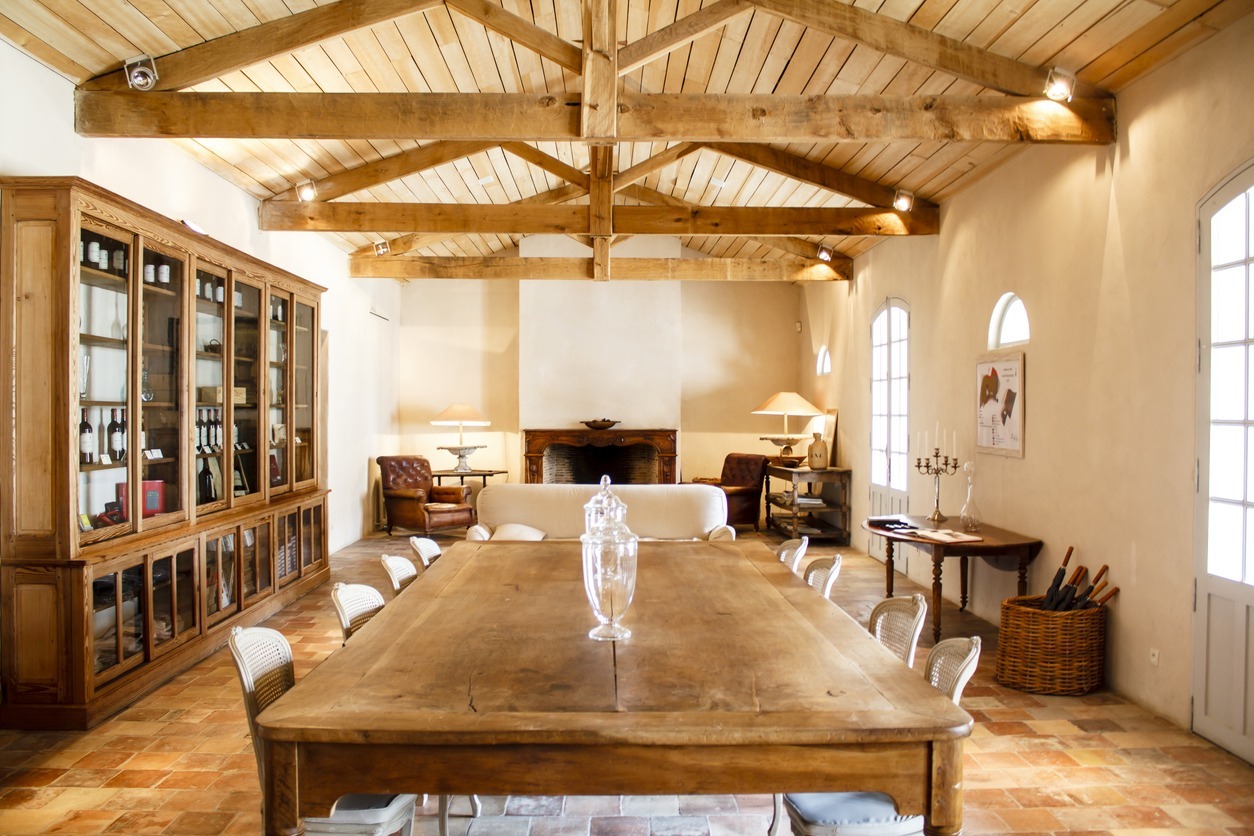Exposed joists or beams are featured in post and beam homes, which can create visual interest and bring individual flair to a home. This type of ceiling is called a beam ceiling. Exposed ceiling beams can add a dramatic sense of strength and weight to a space, and a lot of people like them for their old-world and country-chic appeal.
Beam ceilings are often made using timber, but can also be made from other materials or a combination of materials. They can add interest in an area that is usually neglected, and they can transform the whole room, adding depth and warmth to it. That is why they are a popular design concept. However, not all architectural styles are built to accommodate exposed ceiling beams.
If you are thinking of installing beam ceilings in your home but want to be sure that it is the right decision, we are here to help you. In this article, we are going to give you a guide to beam ceilings, including their history, different types, common materials used, and the important things you need to consider when choosing a beam ceiling style.
History of Beam Ceilings
Overhead beams are a component of timber-frame construction. Although they have an unmistakable aesthetic appeal, their original purpose was entirely practical, which is to support the weight of upper floors and roofs. The precursors of early beams were logs and sticks. They were laid across the tops of stone walls.
When rudimentary tools were invented, craftsmen were able to carve longer beams from larger trees. With this, exposed beam construction became popular, and they began to appear in cottages and castles throughout Europe, the Middle East, the Orient, and virtually all countries as architecture progressed.
In the 1800s, as construction technology advanced, lumber mills became capable of the mass production of wood members. With this, huge overhead beams were slowly replaced by the smaller dimensional lumber used to frame rafters and joists in home construction.
High ceilings and large beams were concealed behind lower, dropped ceilings during remodels from the 1950s to the 1980s to help reduce heating and cooling bills. But post-and-beam construction or timber-frame assembly did not die completely. It is still a feature in mountain homes, ski resorts, cabins, barns, and agricultural buildings.
Structural vs. Decorative Ceiling Beams
There are two major types of ceiling beams, which are structural and decorative. Both of them are available in multiple designs. A lot of people like the natural soft aged wood look and feel of original beams or reclaimed wood box beams. There are also beams that have the original ax or saw marks, which give them a one-of-a-kind appearance. They can be stained, oiled, or painted, but cleaning them can be challenging.
Aside from natural wood, there are also decorative faux beams, which are made of extruded polystyrene or fiberglass. These are easier to install and can be painted or stained to match the design of a home.
Structural Ceiling Beams
When the ceiling beams are structural, this means that they are part of the building envelope construction. They are placed to support second floors and roofs and can be part of the system that keeps walls upright. Structural ceiling beams are made of solid hardwood or steel, and they are very heavy. That is why heavy equipment is also needed to install them. Also, in most jurisdictions, engineering and design approval for structural ceiling beams is needed.
Decorative Ceiling Beams
Decorative ceiling beams are also referred to as faux ceiling beams. They are installed to imitate the look of exposed beam ceilings. The goal of decorative ceiling beams is to provide the look without the weight. They are also not difficult to make and install. There are also ready-made faux ceiling beams available, which are made of polystyrene or molded fiberglass, which are light and easy to use. They come in different sizes and styles, and they look like real wood or steel beams. You can also paint or stain them before installation.
Different Types of Beamed Ceilings
If you are thinking of having beamed ceilings at home, below are some of the different types or styles you can choose from:
Exposed Existing Ceiling Beams
If your home is built before the 1920s, wherein the roof was originally framed with large beams and rafters, it can be easy to achieve your dream of having dramatic exposed ceiling beams. It’s because the beams are already part of the structure. All you have to do is remove the dropped ceiling and restore the beams to their original look.
However, keep in mind that removing the ceiling is not a good solution in all older houses. If the existing structure features standard ceiling joists, narrower than beams, and set closer together, they will not provide the same appearance as bigger beams spaced four to five feet or even farther apart.
But how would you know this? If your dropped ceiling has acoustical tiles, you can push one up and take a look at what lies above using a flashlight. If your ceiling was framed and covered with drywall, the remodelers probably left an access hatch where you could access any wiring or ductwork above the ceiling.
Hammerbeam Roof System
This is popular in English Gothic Architecture. It keeps most support close to the walls and roof deck and leaves the center of the vault unobstructed. Hammer Beams are roof trusses that do not have the engineered central webbing used by modern trusses. They are made of heavy timber, providing support to the roof, and opening up vaulted ceilings to provide large and airy rooms.
The design of the hammerbeam roof system is very distinctive with heavy curved beams giving support for heavy roof beams. This type of beamed ceiling can be added to existing sloped ceilings or vaulted ceiling designs through the use of non-structural box beams.
Box Beams
These are three-sided faux ceiling beams installed on different ceiling finishes to look like solid wood. There are many manufactured textures and colors available for box beams, such as band saw, hand-hewn, and smooth. There are also some manufacturers that make them using reclaimed wood. Most of the time, box beams are used to make coffered ceilings. They are also used to mimic exposed beam ceilings on both vaulted and conventional ceilings.
Steel Beams
Steel can also be used in creating exposed beam ceilings. Both structural and faux steel beams can provide a commercial or industrial look to any space. They can also be painted to match the décor of a room. You also have the option to stain extruded polystyrene or fiberglass faux steel beams to match the theme of any room. But note that structural steel beams can only be installed with an engineer’s certification.
Exposed Joist Beams
These are technically exposed beam ceilings, and they do not look like wood beams. Exposed joist beams are narrower and taller. A lot of them are part of an exposed ceiling where ducts, wires, pipes, and bracing are visible. Most exposed ceilings are painted in one color, and dark gray or black are the most popular options.
Advantages of Beam Ceilings
Decorative beams can definitely add some interest to your home. And aside from that, they come with a lot of benefits as well. Here are some of the advantages you can get from beam ceilings.
Great for extremely high ceilings
Decorative beams can bring the scope of the room down a bit while providing interest.
Can enhance the ceiling
Adding decorative beams to the ceiling can enhance a number of home designs from farmhouses to Tuscan. You just have to make sure that you choose a textured beam that works with the style of the room to complete the design.
Can add value to your home
Beam ceilings create a dramatic visual impact to an area and they can also add an individual touch to your home. They can be made to suit a variety of styles as well. With these, it will also be able to add resale value to your home.
Disadvantages of Beam Ceilings
Though beams are great decorative add-ons to ceilings, they come with a few disadvantages as well. Below are some of them:
Limited headspace
Beam ceilings can make a room feel smaller and more enclosed. Aside from that, they lessen the available headspace in a room, which can be an issue for taller people and rooms with lower ceilings.
Cost
The installation of beam ceilings is more expensive compared to the installation of a standard ceiling. It’s because it requires additional materials and labor.
Difficult to install
Beam ceilings require careful installation to make them safe and secure for the people living in the home. Professionals are needed to install them properly, which also adds to the cost.
Maintenance
Depending on what type of wood you use, beam ceilings may need regular maintenance to avoid warping, splitting, and other damage.
Things to Consider When Choosing Beam Ceilings for Your Home
If you are thinking of having beam ceilings installed in your home, there are different things that you need to do to prepare for a successful ceiling beam installation. These include carefully considering the different styles, sizes, and colors that will match the theme of your home. To help you, below are some of the important things to consider when choosing beam ceilings:
Choose the right beam style
There are endless options when it comes to ceiling beam designs, including the ones we’ve discussed earlier. You need to make sure that the style you will choose will match well with the style and design of your home, as well as with the decorations that you have.
Measure the area carefully
If you are going to install a new wraparound beam over an existing one, you need careful measurements. You need to ensure that the exterior dimensions of the existing beam are smaller compared to the interior dimensions of the new hollow-core beam. Doing this will help you save on additional costs and reduce waste as well.
Take note of obstructions in the area
It is important to note any obstructions on your ceiling that may get in the way of the beam installation. This way, you can avoid a beam running too close to any ceiling protrusions. There are also times when ceiling preparation involves moving light fixtures and other ceiling accessories. You also have to know where each beam will contact walls for you to see where you need to remove a section of crown molding to let the beam fit well to the wall.
Know the dimensions and quantities
Beams spaced from three to six feet apart in the center are common. There are also beams as small as three inches high and five inches wide. It is generally recommended to use smaller beams when the spacings are closer. When the span is long, larger beams should be used. For higher ceilings, wider and deeper beams will work best. For very large ceilings, it is a good idea to use lattice designs across them. For instance, you can mix a large center beam with smaller side beams.
Pick your desired color, look, and feel
You also have to make some fundamental design decisions as you choose your ceiling beams. You can choose between smoother beams or heavily distressed beams, as well as from different colors. You may decide whether you want to go with a complementary or contrasting color. This will depend on the style of your home and your personal preferences.
Consider accessories
You may also want to add some accessories if needed such as brackets, beam plates, straps, and end caps. There are decorative brackets that work well with various beam designs, such as classic, elegant, or modern looks. You may also choose to use decorative beam plates or straps to make the beam installation look more authentic. These can make your ceiling beams more eye-catching.
Conclusion
Beam ceilings can truly add a unique and charming touch to a room. However, there are factors to consider before you decide to install a beam ceiling in your home. These include the type of wood, design options, and maintenance requirements. Beam ceilings can be expensive, but they can surely make any space look more elegant and attractive. Ultimately, the decision to install a beam ceiling should depend on your personal preferences, budget, and style of the room. We hope this article helped you learn more about beam ceilings.

